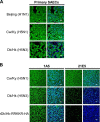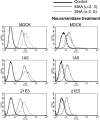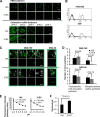Avian Influenza Virus Infection of Immortalized Human Respiratory Epithelial Cells Depends upon a Delicate Balance between Hemagglutinin Acid Stability and Endosomal pH
- PMID: 25673693
- PMCID: PMC4409229
- DOI: 10.1074/jbc.M114.611327
Avian Influenza Virus Infection of Immortalized Human Respiratory Epithelial Cells Depends upon a Delicate Balance between Hemagglutinin Acid Stability and Endosomal pH
Abstract
The highly pathogenic avian influenza (AI) virus, H5N1, is a serious threat to public health worldwide. Both the currently circulating H5N1 and previously circulating AI viruses recognize avian-type receptors; however, only the H5N1 is highly infectious and virulent in humans. The mechanism(s) underlying this difference in infectivity remains unclear. The aim of this study was to clarify the mechanisms responsible for the difference in infectivity between the current and previously circulating strains. Primary human small airway epithelial cells (SAECs) were transformed with the SV40 large T-antigen to establish a series of clones (SAEC-Ts). These clones were then used to test the infectivity of AI strains. Human SAEC-Ts could be broadly categorized into two different types based on their susceptibility (high or low) to the viruses. SAEC-T clones were poorly susceptible to previously circulating AI but were completely susceptible to the currently circulating H5N1. The hemagglutinin (HA) of the current H5N1 virus showed greater membrane fusion activity at higher pH levels than that of previous AI viruses, resulting in broader cell tropism. Moreover, the endosomal pH was lower in high susceptibility SAEC-T clones than that in low susceptibility SAEC-T clones. Taken together, the results of this study suggest that the infectivity of AI viruses, including H5N1, depends upon a delicate balance between the acid sensitivity of the viral HA and the pH within the endosomes of the target cell. Thus, one of the mechanisms underlying H5N1 pathogenesis in humans relies on its ability to fuse efficiently with the endosomes in human airway epithelial cells.
Keywords: Avian Influenza Virus; Endosomal pH; Endosome; Epithelial Cell; Hemagglutinin; Membrane Fusion; Tropism; Viral Protein; Virus Entry.
© 2015 by The American Society for Biochemistry and Molecular Biology, Inc.
Figures








Similar articles
-
HA-Dependent Tropism of H5N1 and H7N9 Influenza Viruses to Human Endothelial Cells Is Determined by Reduced Stability of the HA, Which Allows the Virus To Cope with Inefficient Endosomal Acidification and Constitutively Expressed IFITM3.J Virol. 2019 Dec 12;94(1):e01223-19. doi: 10.1128/JVI.01223-19. Print 2019 Dec 12. J Virol. 2019. PMID: 31597765 Free PMC article.
-
[Host-adaptive mechanism of H5N1 avian influenza virus hemagglutininn].Uirusu. 2015;65(2):187-198. doi: 10.2222/jsv.65.187. Uirusu. 2015. PMID: 27760917 Review. Japanese.
-
Unique Infectious Strategy of H5N1 Avian Influenza Virus Is Governed by the Acid-Destabilized Property of Hemagglutinin.Viral Immunol. 2017 Jul/Aug;30(6):398-407. doi: 10.1089/vim.2017.0020. Epub 2017 Jun 27. Viral Immunol. 2017. PMID: 28654310 Review.
-
A Dual Motif in the Hemagglutinin of H5N1 Goose/Guangdong-Like Highly Pathogenic Avian Influenza Virus Strains Is Conserved from Their Early Evolution and Increases both Membrane Fusion pH and Virulence.J Virol. 2018 Aug 16;92(17):e00778-18. doi: 10.1128/JVI.00778-18. Print 2018 Sep 1. J Virol. 2018. PMID: 29899102 Free PMC article.
-
The pH of activation of the hemagglutinin protein regulates H5N1 influenza virus replication and pathogenesis in mice.J Virol. 2013 May;87(9):4826-34. doi: 10.1128/JVI.03110-12. Epub 2013 Feb 28. J Virol. 2013. PMID: 23449784 Free PMC article.
Cited by
-
The host tropism of current zoonotic H7N9 viruses depends mainly on an acid-labile hemagglutinin with a single amino acid mutation in the stalk region.PLoS Pathog. 2024 Oct 22;20(10):e1012427. doi: 10.1371/journal.ppat.1012427. eCollection 2024 Oct. PLoS Pathog. 2024. PMID: 39436936 Free PMC article.
-
Modulation of the pH Stability of Influenza Virus Hemagglutinin: A Host Cell Adaptation Strategy.Biophys J. 2016 Jun 7;110(11):2293-2301. doi: 10.1016/j.bpj.2016.04.035. Biophys J. 2016. PMID: 27276248 Free PMC article. Review.
-
The Major Hurdle for Effective Baculovirus Transduction into Mammalian Cells Is Passing Early Endosomes.J Virol. 2019 Jul 17;93(15):e00709-19. doi: 10.1128/JVI.00709-19. Print 2019 Aug 1. J Virol. 2019. PMID: 31092570 Free PMC article.
-
Characterization of changes in the hemagglutinin that accompanied the emergence of H3N2/1968 pandemic influenza viruses.PLoS Pathog. 2021 Sep 23;17(9):e1009566. doi: 10.1371/journal.ppat.1009566. eCollection 2021 Sep. PLoS Pathog. 2021. PMID: 34555124 Free PMC article.
-
Evolutionary pressures rendered by animal husbandry practices for avian influenza viruses to adapt to humans.iScience. 2022 Mar 1;25(4):104005. doi: 10.1016/j.isci.2022.104005. eCollection 2022 Apr 15. iScience. 2022. PMID: 35313691 Free PMC article. Review.
References
-
- World Health Organization (2013) Cumulative number of confirmed human cases of avian influenza A/(H5N1) reported to WHO. www.who.int/influenza/human_animal_interface/EN_GIP_20131210CumulativeNu...
-
- Shinya K., Ebina M., Yamada S., Ono M., Kasai N., Kawaoka Y. (2006) Avian flu: influenza virus receptors in the human airway. Nature 440, 435–436 - PubMed
-
- van Riel D., Munster V. J., de Wit E., Rimmelzwaan G. F., Fouchier R. A., Osterhaus A. D., Kuiken T. (2006) H5N1 virus attachment to lower respiratory tract. Science 312, 399. - PubMed
-
- Fouchier R. A., Schneeberger P. M., Rozendaal F. W., Broekman J. M., Kemink S. A., Munster V., Kuiken T., Rimmelzwaan G. F., Schutten M., Van Doornum G. J., Koch G., Bosman A., Koopmans M., Osterhaus A. D. (2004) Avian influenza A virus (H7N7) associated with human conjunctivitis and a fatal case of acute respiratory distress syndrome. Proc. Natl. Acad. Sci. U.S.A. 101, 1356–1361 - PMC - PubMed
Publication types
MeSH terms
Substances
LinkOut - more resources
Full Text Sources
Medical
Research Materials

